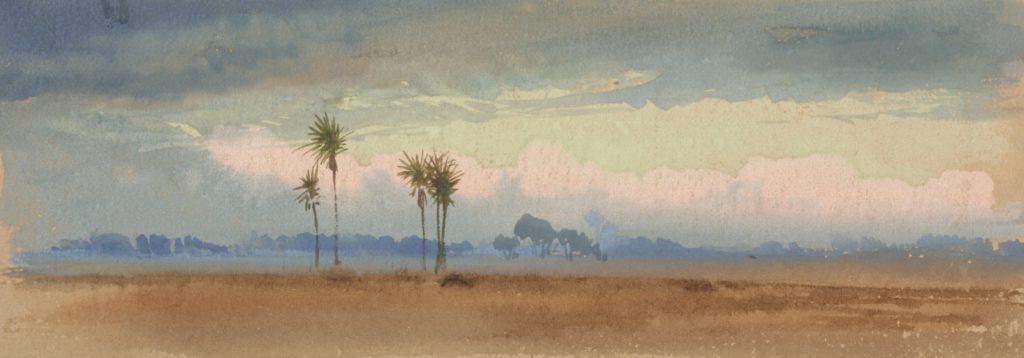
The palm-tree is the picture of the practical life of service. “Ourselves your servants for Jesus’ sake” – this is the palm-tree’s lesson.
It gives its wood for the rafters of the Arab house; its leaf stalks for its laths, for his fences, his spring mattress, the cradle for his baby; the stem is woven to be his ropes, and the leaves, stripped off, plait into his basket, his hat, the mat for his floor. The three parts – leaf for paper, rods for sticks, chump ends for coal – make his fuel. These chump ends of the leafstalks also serve as hockey sticks for his boys and for tombstones for his dead.
Then comes the fruit-bearing for his sustenance and support – seventy named varieties of dates, from the ‘deglet en nour’ of the caids’ table, to the hard, acorn-like variety (“heavenly biscuits” we used to call them) that rattle in your hand. And even the datestalks have their use as brooms, and the date-stones, saved into the gullet of the longsuffering camel, form his food on a long trek when there is no better.
And even yet the palm-tree has not given its uttermost. “I will very gladly spend and be spent out for you” finds a last fulfillment. The tree bears till it can bear no more and stands with a little crown of shabby looking leaves, hardly more than a cabbage-like tuft. The Arab swarms up the trunk with a gourd, and lops it off, and the gourd fills with rich sweet palm wine. The tree has kept its best for that last act of service.
“The Son of Man came not to be ministered unto, but to give His life.” It is from the Son of Man that we have learnt to minister; some outpoured “giving” may be silently preparing, to crown the little un-noticed ministries.
And when we think of the palm-tree bringing all this out of the impossible soil of the desert, we see how its fronds have won the right to be the symbol of victory – victory over our circumstances – bringing the very best out of our lives by the same conditions as the palm. It must stand, so the natives say, with its feet in the water and its head in the fire, and so must we.
Are we studying like the palm, to become available to the uttermost to those around us “for Jesus’ sake”? To the natives, to our fellow-missionaries, to the household whose atmosphere we help to make or mar? And this not in a haphazard way, but with lives laid down in sacrifice, our responsibility being not only what we are when we arrive, but what we have the power to become in spirit, soul, and body.
Nor does the matter end thus – rather, thus does it begin. If we study the parable of the talents and the pounds, we see the bearing of faithfulness to opportunity great and small on the time when the King comes back having received the Kingdom. And beyond that again who can say where the fruitage may end, for this life’s “patient continuance in well-being”? For “He that is faithful in that which is least, is faithful also in much.” The harvest of the trivial and the monotonous may lie out beyond the stars.
~ Lilias Trotter (June 10, 1928)
*The date palm has been named, along with the camel, as one of the two treasures of the Southland. Little wonder that Lilias looked to the hardy practicality of the palm tree as a symbol of service, identifying how each part of the palm – wood, leaf, leafstalks, stem, dates, date stones – provides support, sustenance and even sport. The ultimate service and victory (!) of the palm tree, like that of “The Son of Man,” came with its dying offering: “The rich sweet palm wine.” MHR

